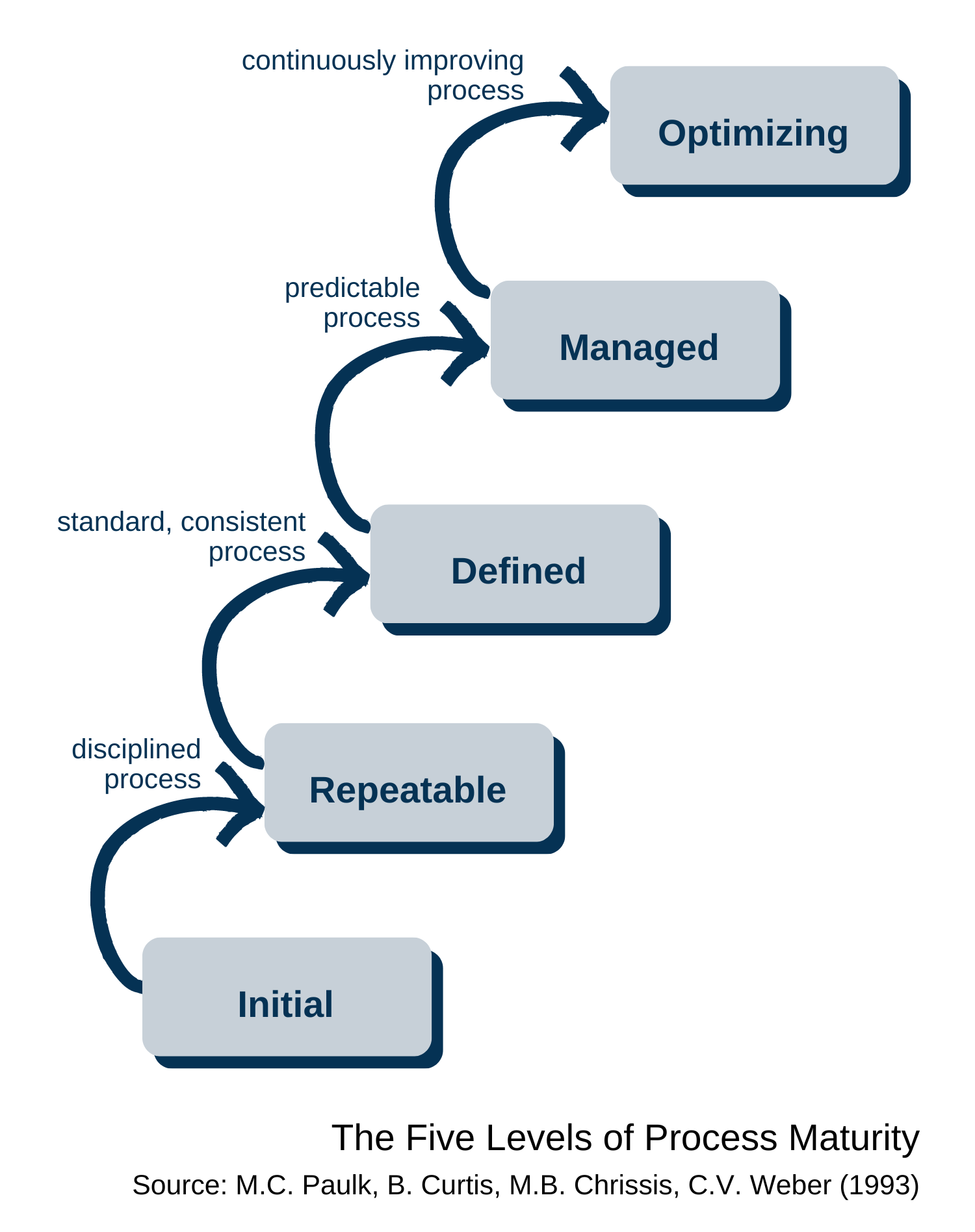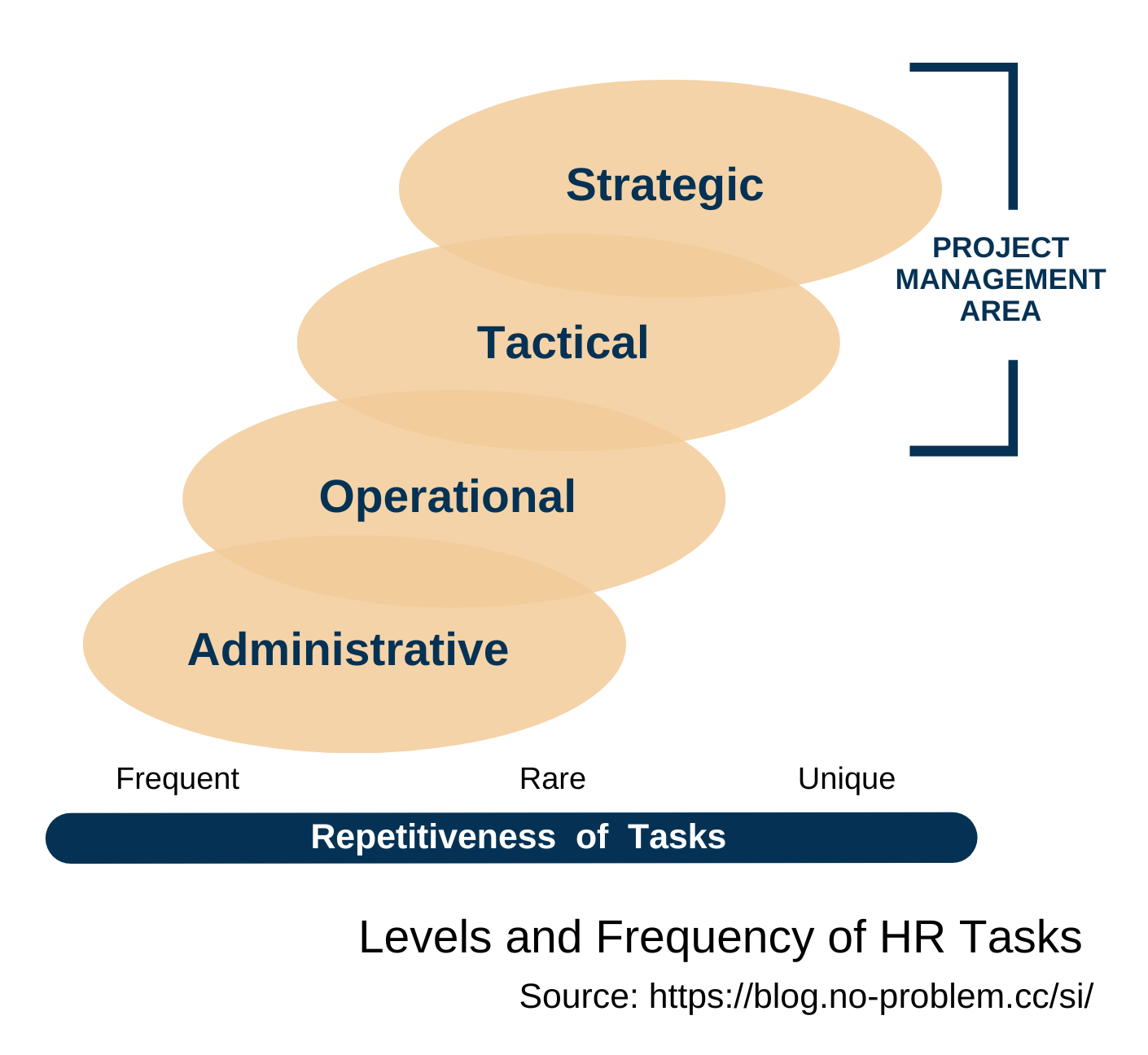Transformation of HR Processes:
from chaos to ecosystem
According to Wikipedia, a process “is a series or set of activities that interact to produce a result; it may occur once-only or be recurrent or periodic“. These activities are to be decomposed into some number of steps, sequenced in a specific order, and performed for a purpose. In a business, multiple processes work together to achieve a company’s goals. Processes are the carcass of any complex organization. They serve to reduce chaos and provide systematic approaches, methods, practices, and procedures to deal with both repetitive and unique tasks.
Process maturity is the extent to which a specific process is explicitly defined, managed, measured, controlled, and effective. One of the most commonly used process maturity frameworks derives from the software development area, where the quality of processes has an immediately visible effect on business results. It is a part of the Capability Maturity Model for Software (CMM). The framework comprises five levels:

- Initial: The process is characterized as ad hoc, and occasionally even chaotic. Few processes are defined, and success depends on individual efforts.
- Repeatable: Basic processes are established. Some processes are repeatable, possibly with consistent results.
- Defined: There are sets of defined and documented standard processes established and subject to some degree of improvement over time.
- Managed: Detailed measures of the process and outcome quality are collected and controlled.
- Optimizing: Continuous process improvement is enabled by quantitative feedback from the process and from piloting innovative ideas and technologies.
The maturity of processes’ organization indicates both the richness of a company’s processes and the consistency with which it is applied in an enterprise. At a given time, different processes can be assigned to diverse maturity levels that affect the overall level of an organization of processes. With an immature organization, most processes are improvised by practitioners and even specified ones are not rigorously followed or enforced. With a mature organization, processes are accurately communicated to executors and other stakeholders, work activities are carried out according to the planned processes, and the quality of outcome and customer satisfaction is monitored, controlled, and continuously improved. The more mature an organization of processes is better an objective, quantitative basis for judging quality and analyzing problems with outcomes and processes themselves.
Starting from some degree of organizational development, processes tend to be integrated, interconnected, and organized into a common system. As a company matures, its processes become better defined within and across different business areas and more consistently implemented throughout the organization. HR is made up of complex, intertwined processes and systems, which are highly integrated into and influenced by a company’s culture, strategy, and operational business objectives. Often the maturity of HR processes reflects the attitude and the way the organization of processes in a company or trails a little bit behind.
Reinvent the wheel
This is the starting stage where any task is titled as a strategic challenge requiring an elaboration of a unique solution. This is a typical situation for startups and unfortunately not a rare case for mid-sized companies. The key characteristics of the HR function at this stage are a lack of systematic approach, chaotic organization of work, unpredictable outcomes for similar tasks, and high dependence of results on individual efforts. These might foster a forming of counterproductive working habits, which hamper the movement to the next organizational level and a significant resistance of executors to changes. The immature HR organization is reactionary, and practitioners are usually focused on solving immediate crises. A prolonged jamming at this stage prevents HR from being considered a reliable partner and a value-add for the business.
The first transformative step from the chaos is to identify administrative, operational, tactical, and strategic HR tasks and classify them in terms of repetitiveness, for example, frequent, rare, and unique. In an immature organization, a portfolio of HR services is very limited and most probably bounded by the basics of administrative and operational tasks. For frequent administrative and operational working tasks, appropriate processes and clear procedures should be designed. A high task recurrence allows practitioners to test and quickly tune processes to be effective. Because of the relative simplicity of tasks, these processes are to be simple, transparent, with clear input and output data, and well-defined and documented sets of required sequential steps. To maximize the effect, these processes are to be coherent to arrange them into simple working systems.
One of the essential hindrances at this stage is the capability of HR practitioners, who dealt with truncated HR processes only, to design appropriate consistent processes for different HR areas. A shortcut solution in this situation can be the adoption of processes embedded into one of HRTech solutions offered by software providers. Another option is to invite an external consultant or a process manager from a business to help HR practitioners set up steady and scalable processes. Besides the capability of processes’ design and implementation, supportive change management activities have to be undertaken to ensure smooth and efficient transformation.
Replicate results
This is the next stage of the organization of HR processes on the maturity journey. The main characteristics of the HR function at this level are defined processes for most repetitive tasks, minor deviation of results for similar activities, low dependence on specifics of executors, a set of independent systems and processes with a partial overlapping and the necessity of manual input or Excel-based data exchange between them. Because of the stable delivery of acceptable outcomes for the majority of administrative and operational tasks, HR is a respected function for the business.
A lot of companies are stuck at this level polishing instead of improving processes and maintaining instead of optimizing a lot of outdated systems. To move forward, HR organization is to focus on bundling independent systems into complex ones to reduce partial duplication of processes and decrease the number of mistakes caused by significant manual data handling. Many processes are to be automated. On the market, there are plenty of HRTech solutions to be selected from and to fit the specific requirements of a company to functionality, set of HR processes, and degree of customization. Such a solution can be embedded into the company’s system of HR processes or the internal organization of HR processes can be adjusted to the solution’s requirements.
 Digitalization of HR processes to support the employee lifecycle and a positive employee experience requires significant change management activities to get the acceptance and commitment of all affected stakeholders. To solve such a task, HR practitioners have to know the basics of project management and be capable of applying it in practice. This is another area of improvement. The application of project management to deal with tactical and strategic tasks facilitates HR to become more flexible, proactive, and strategic.
Digitalization of HR processes to support the employee lifecycle and a positive employee experience requires significant change management activities to get the acceptance and commitment of all affected stakeholders. To solve such a task, HR practitioners have to know the basics of project management and be capable of applying it in practice. This is another area of improvement. The application of project management to deal with tactical and strategic tasks facilitates HR to become more flexible, proactive, and strategic.
Continuous improvement
This is the advanced stage. The main characteristics of the mature HR function are high automation with the necessary infrastructure to support it, a system of HR processes that ensures managed processes and predictable results for repetitive tasks, a confident handling of unique challenges, a strong focus on the quality of outcome, and integration with some business processes. Roles and responsibilities within the defined processes are clear across the HR and other affected functions. HR organization is a valuable asset for a company and a reliable partner for the business.
Any process is going to have variations. The normal variation within a process is caused by the process itself (for example, typing errors by HR admins). If the output of one process serves as an input for another process, deliberate tracking, control, and management of normal variations open a great reserve for refinements. Continuous process improvement is based on many small, evolutionary steps rather than revolutionary innovations. It should focus on the needs of the HR function in the context of its business environment. Besides cost-effectiveness, agility, and adaptability to business needs, transparency, consistency, predictability, and plainness are core requirements of HR processes and systems. To get better results, efforts should be placed on enhancing the quality of input and output data, optimization of process steps and procedures, shrinking and aligning variations, and tighter integration of HR processes into one common system. The transformative step at this stage is an evolutional move to the HR ecosystem covering all HR-related areas, deeply embedded into a complex business processes system of a company, and embraced by the required project management and culture change activities.
The ecosystem of HR processes is the desired transformative objective. A lot of companies set this transformation as the immediate HR target, ignoring the actual maturity degree of the organization. The ability to implement processes from higher maturity levels does not imply that some levels can be skipped, because each forms a necessary foundation from which to achieve the next stage. HR processes are dedicated to driving job satisfaction, engagement, and productivity of employees, providing a ground for the HR business partnering, shaping the corporate culture, and supporting business in the achieving its strategic goals. In other words, they serve the needs of people and the business. Therefore, the maturity of the organization of HR processes is tightly linked and should be balanced with the maturity level of the company.
Read this article on LinkedIn

